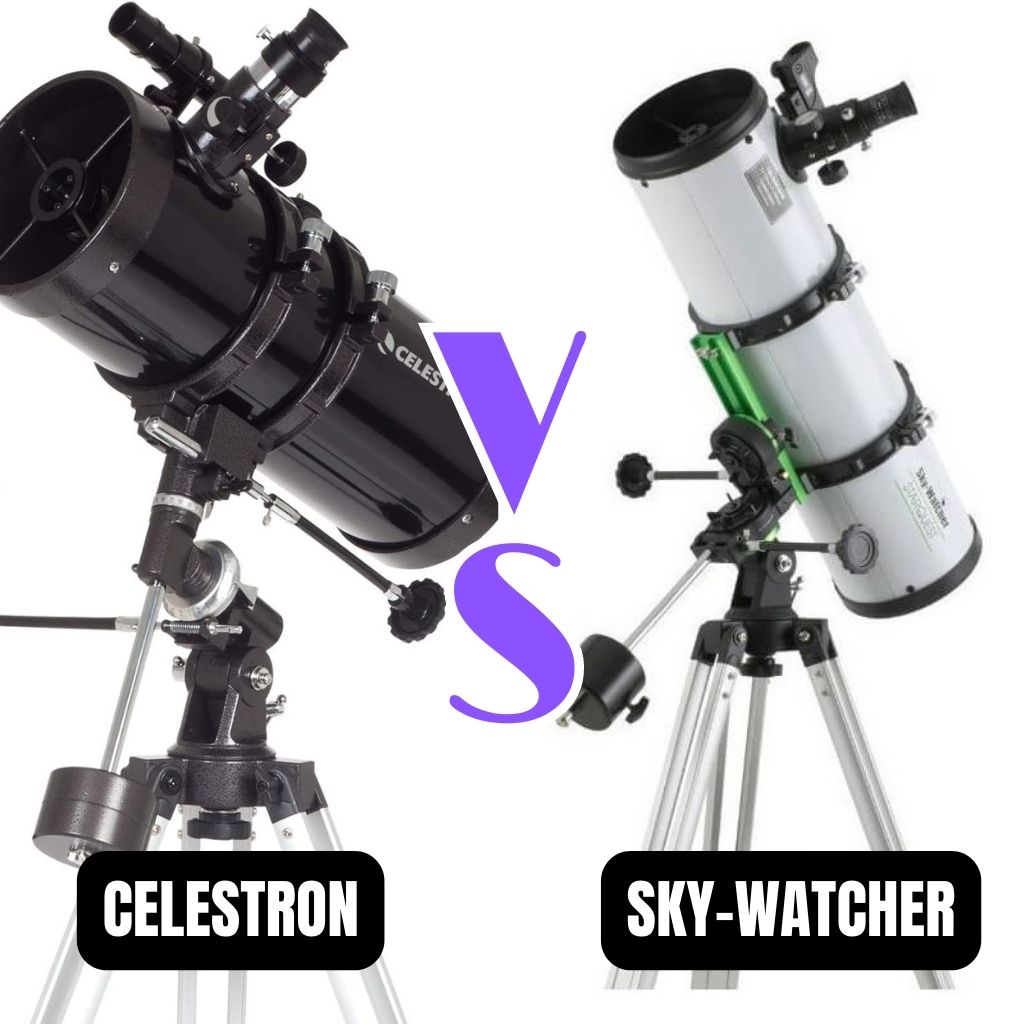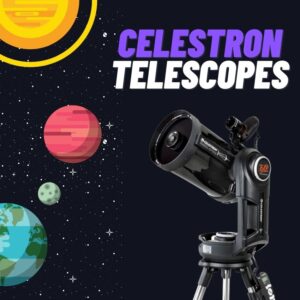This site contains affiliate links to products. I may receive a commission for purchases made through these links.
When it comes to telescopes, two of the most popular brands on the market are Celestron and Sky-Watcher. Both offer a wide range of high-quality telescopes with various features and specifications to suit your needs.
Celestron and Sky-Watcher have established themselves as leading players in the telescope industry, catering to the needs of astronomers, hobbyists, and professionals.
The brands offer a diverse selection of telescopes, encompassing a wide range of sizes, types, and advanced functionalities.
In this article, we’ll compare and contrast the offerings of Celestron and Sky-Watcher, highlighting the strengths and weaknesses of each brand to help you make an informed decision about which one to choose.
Are Celestron and Sky-Watcher telescopes the same?
Celestron and Sky-Watcher telescopes are not the same. They are two different brands that manufacture telescopes for various purposes.
Although both brands are popular and well-known, they have their own unique features and differences that set them apart from each other.
Celestron vs Sky-Watcher in a nutshell
If you’re in the market for a telescope, chances are you’ve come across Celestron and Sky-Watcher. Both are well-known brands in the astronomy community and offer a wide range of telescopes.
Let’s consider some important factors when choosing either Celestron or Sky-Watcher telescopes, including observing goals, image quality, ease of use, portability, and budget.
Observing goals
When it comes to observing goals, both Celestron and Sky-Watcher have something to offer.
Celestron telescopes are known for their versatility, making them a great choice for both terrestrial and celestial viewing.
Sky-Watcher telescopes, on the other hand, are designed with astronomy in mind. They often come with features like large apertures and long focal lengths, making them ideal for deep sky observations.
Image quality
Image quality is a crucial factor to consider when choosing a telescope, and both Celestron and Sky-Watcher offer high-quality optics.
Celestron telescopes often come with Schmidt-Cassegrain or Maksutov-Cassegrain optics, while Sky-Watcher telescopes frequently use parabolic mirrors.
Both designs have their advantages and disadvantages, but overall, they provide excellent image quality.
Ease of use
Ease of use is an essential factor to consider, especially if you’re a beginner.
Celestron telescopes are known for their user-friendly designs and often come with advanced features like computerized mounts and intuitive controls.
Sky-Watcher telescopes are beginner friendly and offer features like tracking systems and GoTo mounts, which can be a big plus for experienced astronomers.
Portability
Portability is another critical factor to consider when choosing a telescope.
Both Celestron and Sky-Watcher offer telescopes in a range of sizes, from small and portable to large and bulky.
Celestron telescopes tend to be more portable and lightweight, while Sky-Watcher telescopes are often designed for stationary use.
Budget
Budget is always an important consideration when choosing a telescope.
Both Celestron and Sky-Watcher offer telescopes at a range of price points, from budget-friendly options for beginners to high-end telescopes for experienced astronomers.
Celestron telescopes tend to be slightly more expensive overall, but Sky-Watcher telescopes can also be quite pricey, especially if you’re looking for a large aperture or advanced features.
Is Celestron a good telescope brand?
Celestron is one of the most respected brands in the world of telescopes and astronomy. The company has been in the business for over 50 years and is known for producing high-quality telescopes for beginners and experienced astronomers alike.
Celestron has an excellent reputation for its quality, innovation, and customer service.
One thing that makes Celestron a good telescope brand is its commitment to quality.
Celestron telescopes are made with high-quality materials and are built to last. They come with a warranty that covers any defects or problems that may arise.
Celestron is also known for its innovative products. The company has introduced several new technologies to the market, including computerized telescopes and GoTo mounts.
These innovations have made stargazing more accessible and enjoyable for amateur astronomers.
In terms of customer service, Celestron has an excellent reputation. The company provides excellent customer support and resources, including user manuals, online forums, and customer support hotlines.
Want to learn more about this? Read the full article here: Is Celestron a Good Telescope Brand?
Where are Celestron telescopes produced?
Celestron is headquartered in Torrance, California, USA. The parent company, Synta Technology Corporation, manufactures its products in Taiwan.
The company produces telescopes and distributes a wide range of related products, such as binoculars, spotting scopes, microscopes, and accessories.
Celestron maintains high standards for quality control and ensures that all their telescopes meet strict specifications before they are released to the market.
What are the best Celestron telescope models?
Whatever your observing goals and budget, Celestron has a telescope model that will meet your needs and deliver impressive performance.
Here are some of their best telescope models:
Celestron NexStar 8SE Telescope – Best for deep sky observation
The Celestron NexStar 8SE Telescope is a Schmidt-Cassegrain telescope that comes with an 8-inch aperture and a focal length of 2032 mm.
It also features a fully automated GoTo mount that can locate and track objects in the sky with precision.
The Celestron NexStar 8SE Telescope comes with a finder scope. Finder scopes are helpful tools that aid in locating celestial objects by providing a wider field of view than the main telescope.
This telescope is an excellent choice for intermediate to advanced stargazers who want to explore deep-sky objects.
Full review here: Celestron NexStar 8SE Telescope Review
Celestron NexStar 6SE Telescope – Best for beginners and intermediate observers
The Celestron NexStar 6SE Telescope, a smaller version of the NexStar 8SE, features a 6-inch aperture and a focal length of 1500 mm.
It is ideal for beginners and intermediate users seeking a portable and user-friendly telescope without compromising image quality.
The fully automated GoTo mount ensures effortless navigation through the night sky.
Celestron Omni XLT 150 Reflector Telescope – Best for exploring deep sky objects and astrophotography
Offering a larger aperture of 6 inches and a focal length of 750mm, the Celestron Omni XLT 150 Reflector Telescope delivers impressive views of the night sky.
Its sturdy equatorial mount provides stability and smooth tracking. This telescope is well-suited for those interested in exploring deep sky objects and astrophotography.
Celestron CPC Deluxe 1100 HD Telescope – Best for advanced stargazers
The Celestron CPC Deluxe 1100 HD Telescope is a high-end telescope designed for advanced stargazers. It features an 11-inch aperture and a focal length of 2800 mm, providing excellent image quality and detail.
This telescope comes with a heavy-duty tripod and a fully automated GoTo mount, making it easy to find and track objects in the sky.
Read the full review here: Celestron CPC 1100 Telescope Review
Celestron NexStar Evolution 9.25 Telescope – Best for advanced users and astrophotography
Combining advanced features and portability, the Celestron NexStar Evolution 9.25 Telescope features a 9.25-inch aperture and a focal length of 2350mm.
It comes with built-in WiFi, enabling wireless control via a smartphone or tablet.
With its Schmidt-Cassegrain design and excellent optics, this telescope is favored by intermediate and advanced users, particularly for astrophotography.
Celestron CGX-L Telescope – Best for astrophotography
The Celestron CGX-L Telescope is a large, high-end telescope that is perfect for serious stargazers. It features a massive 14-inch aperture and a focal length of 3910 mm, providing stunning views of deep sky objects.
The CGX-L also comes with a fully automated GoTo mount and a heavy-duty tripod, making it easy to find and track objects in the sky.
Celestron AstroFi 130 Telescope – Best budget-friendly telescope and astrophotography
The Celestron AstroFi 130 Telescope is a budget-friendly telescope that is perfect for beginners. It features a 130mm aperture and a focal length of 650mm, providing decent image quality for its price range.
This telescope also comes with built-in WiFi and a smartphone app, allowing users to control the telescope using their mobile devices.
Celestron NexStar 4SE Telescope – Best compact telescope
Perfect for compact portability, the Celestron NexStar 4SE Telescope features a 4-inch aperture and a focal length of 1325mm. It comes with a fully automated GoTo mount, making it easy to locate and track celestial objects.
The 4SE is an excellent choice for both beginners and intermediate users who value convenience and versatility.
You may also like: Celestron NexStar 4SE Review (Read Before Purchasing)
Celestron Inspire 100AZ Refractor Telescope – Best for beginners and casual stargazers
Designed for beginners and casual stargazers, the Celestron Inspire 100AZ Refractor Telescope offers a 100mm aperture and a focal length of 660mm.
Its altazimuth mount allows for easy and intuitive navigation of the night sky. The Inspire 100AZ is a great entry-level option for observing celestial objects with clear and crisp views.
Celestron NexStar 130SLT Telescope – Best for visual observation and entry-level astrophotography
With a 130mm aperture and a focal length of 650mm, the Celestron NexStar 130SLT Telescope is a versatile and user-friendly instrument.
It features a computerized hand control with over 4,000 celestial objects database, enabling automatic tracking and precise locating.
This telescope is a popular choice for beginners and intermediate users interested in both visual observation and astrophotography.
Is Sky-Watcher a good telescope brand?
Sky-Watcher is considered a reputable and reliable telescope brand among both amateur and professional astronomers. The company was founded in 1999.
It has since grown to become one of the largest manufacturers of telescopes in the world.
Sky-Watcher telescopes are known for their high-quality optics, advanced features, and affordability.
They offer a wide range of telescopes, from entry-level models for beginners to professional-grade instruments for advanced users.
One of the reasons why Sky-Watcher has gained popularity among astronomers is its ability to produce telescopes that offer great value for money. Sky-Watcher telescopes are priced reasonably, making them accessible to beginners and those on a budget.
In terms of quality, Sky-Watcher telescopes are highly regarded by the astronomy community. They are known for their high-quality optics and advanced features that make them easy to use and suitable for a wide range of observing tasks.
In general, Sky-Watcher is a well-respected telescope brand that offers quality instruments at affordable prices, making it an excellent choice for both beginners and experienced astronomers.
Where are Sky-Watcher telescopes produced?
Sky-Watcher telescopes are produced in China by Synta Taiwan’s Suzhou Synta Optical Technology Co., Ltd. in Suzhou (Jiangsu).
The company is strongly committed to research and development and continues to innovate and improve their products.
Sky-Watcher also has a strong customer service team that provides support to customers worldwide.
What are the best Sky-Watcher telescope models?
Sky-Watcher offers a range of exceptional telescope models that cater to the needs of both beginners and experienced astronomers.
From their compact and portable options to their high-end telescopes for advanced stargazers, Sky-Watcher has earned a reputation for producing quality instruments.
Some of the best Sky-Watcher telescope models include:
Sky-Watcher Evostar 120 APO-Best for Astrophotography
Sky-Watcher Evostar 120 APO is an apochromatic refractor telescope that is ideal for astrophotography and provides crystal-clear images of the night sky.
The telescope’s 120mm aperture and dual-speed focuser make capturing detailed images of celestial objects easy.
Sky-Watcher Dobsonian 8-inch – Best for deep sky observation
The Sky-Watcher Dobsonian 8-inch telescope offers a large aperture and a stable Dobsonian mount, making it perfect for deep sky observation.
With an 8-inch primary mirror, it gathers ample light to reveal faint galaxies, nebulae, and star clusters.
The telescope’s simple yet robust design ensures easy setup and smooth operation, allowing beginners and experienced astronomers alike to enjoy impressive views of the night sky.
Sky-Watcher Quattro 10-inch – Best for astrophotography
The Sky-Watcher Quattro 10-inch is a high-performance reflector telescope designed for astrophotography. It features a 10-inch parabolic primary mirror and a 2-inch dual-speed Crayford focuser, enabling precise focusing and capturing fine details of celestial objects.
The telescope’s four-element design minimizes chromatic aberration, producing sharp, color-accurate images.
With its sturdy construction and excellent optical performance, the Quattro 10-inch is a top choice for astrophotographers seeking outstanding image quality.
Sky-Watcher Esprit 120ED – Best for astrophotography and visual observation
The Sky-Watcher Esprit 120ED is a premium apochromatic refractor telescope designed for both astrophotography and visual observation.
With a 120mm aperture and a focal length of 840mm, it delivers exceptional image quality and color correction.
The telescope features a 3-element objective lens, a dual-speed 3″ Crayford focuser, and a robust build quality.
Whether you are capturing detailed images or enjoying breathtaking views of celestial objects, the Esprit 120ED offers uncompromising performance.
Sky-Watcher Explorer 130P – Best for beginners
The Sky-Watcher Explorer 130P is a Newtonian telescope and an excellent choice for beginner astronomers looking to explore the wonders of the night sky.
This user-friendly reflector telescope features a 130mm (5.1-inch) aperture, which allows for impressive light-gathering capability. The focal ratio of the Sky-Watcher Explorer 130P is f/5.
The optical tube assembly (OTA) of the Sky-Watcher Explorer 130P is designed to provide optimal performance.
With its larger aperture, the Explorer 130P offers enhanced clarity and detail when observing celestial objects.
Equipped with a parabolic primary mirror, this telescope delivers sharp and well-defined images. It provides clear views of the moon, revealing intricate lunar details such as craters, mountains, and maria.
When observing planets like Jupiter, Saturn, and Mars, the Explorer 130P offers glimpses of their fascinating features, including cloud bands, planetary rings, and polar ice caps.
You may also like: Sky-Watcher Explorer 130P Review (Read Before Purchase)
Sky-Watcher Dobsonian 10-inch – Best for deep sky observation
The Sky-Watcher Dobsonian 10-inch telescope is a powerful instrument for observing deep sky objects. Its large aperture allows for impressive light-gathering capability, revealing intricate details of galaxies, nebulae, and star clusters.
The sturdy Dobsonian mount provides stability and ease of use, making it a popular choice among amateur astronomers.
You may also like: Top 3 Sky-Watcher 10-inch Dobsonian Telescopes
Sky-Watcher Evostar 80mm Doublet APO – Best travel telescope
The Sky-Watcher Evostar 80mm Doublet APO is a compact and portable telescope that excels in both visual observation and astrophotography.
Its 80mm aperture and high-quality optics provide sharp and detailed views of celestial objects. Its lightweight design and included travel case make it convenient for stargazing on the go or for those with limited storage space.
Sky-Watcher Skymax 90mm Maksutov-Cassegrain – Best compact telescope
The Sky-Watcher Skymax 90mm Maksutov-Cassegrain is a compact and versatile telescope renowned for its high-contrast views.
With its 90mm aperture and Maksutov-Cassegrain optical design, it delivers sharp and clear images of the moon, planets, and smaller deep sky objects.
The compact size and lightweight nature make it an excellent choice for astronomers who value portability without compromising on image quality.
To go further, check out this full guide: Sky-Watcher Telescopes
Celestron vs Sky-Watcher, which one’s for you?
Choosing between Celestron and Sky-Watcher telescopes depends on your specific preferences and requirements. Each brand offers unique features and advantages that cater to different needs.
Here are a few considerations to help you make a decision:
Celestron excels in astrophotography, while Sky-Watcher focuses on visual observations
The type of observing goals you have will play a significant role in determining which brand to choose. Celestron telescopes are generally more popular for astrophotography, while Sky-Watcher is better suited for visual observations.
If you’re interested in deep space astrophotography, Celestron telescopes with advanced tracking and imaging capabilities may be the right choice.
But if you’re more interested in observing the planets and moon, Sky-Watcher telescopes are a great choice due to their higher quality optics and larger aperture sizes.
Sky-Watcher telescopes are more beginner-friendly compared to Celestron telescopes
Sky-Watcher telescopes are generally considered to be easier to set up and use, with many models featuring intuitive designs and user-friendly controls.
Celestron telescopes, on the other hand, may require a bit more effort to set up and operate, but they offer more advanced features and functionality.
Celestron targets intermediate-level astronomers with technical product descriptions, while Sky-Watcher focuses on beginners.
Celestron has more innovative features than Sky-Watcher
Celestron is known for its pioneering Schmidt-Cassegrain models and innovative features, while Sky-Watcher has excelled in producing Dobsonians and Maksutov-Cassegrains.
However, both brands focus on providing quality optics for clear viewing experiences.
Sky-Watcher has more affordable telescopes than Celestron
The cost of telescopes can vary widely, and both Celestron and Sky-Watcher offer a range of models at different price points.
Sky-Watcher telescopes tend to be more affordable, making them a great choice for beginners or those on a tight budget.
Celestron telescopes, on the other hand, can be more expensive, but they offer more advanced features and capabilities, making them a great choice for more experienced users.
FAQs about Celestron & Sky-Watcher telescopes
Here are answers to some frequently asked questions:
Is Sky-Watcher a Chinese company?
Sky-Watcher is a Chinese company that specializes in manufacturing high-quality telescopes for astronomy enthusiasts.
Celestron, Orion, or Sky-Watcher, which is better?
It’s not a straightforward answer, as each of these brands has its own strengths and weaknesses.
Celestron has a wide range of telescopes that cater to various needs, from beginner to advanced users. They are known for their computerized telescopes, which are easy to set up and use.
Orion, on the other hand, has a reputation for manufacturing high-quality telescopes and accessories. They are popular among astrophotographers and offer a range of advanced features for imaging.
Sky-Watcher is a budget-friendly brand that offers a variety of telescopes for beginners and intermediate users. They have gained a reputation for producing high-quality Newtonian reflectors and Dobsonian telescopes.
Orion telescopes vs Celestron, which is better?
Selecting between a Celestron and Orion telescope depends on your individual requirements and preferences, as each brand offers distinct advantages and disadvantages.
Orion telescopes are known for their high-quality optics, and they offer a wide range of products that are suitable for beginners as well as advanced users. They are also often more affordable than Celestron telescopes.
On the other hand, Celestron telescopes are known for their advanced features and technology, such as computerized tracking and GPS capabilities. They also offer a wider range of models and accessories, which can be useful for those who want to customize their telescope setup.
Celestron vs Meade telescopes, which is better?
Celestron and Meade are both popular telescope brands, each with its own strengths and weaknesses. It ultimately depends on what you are looking for in a telescope.
Celestron offers a wider range of telescope models, including computerized and advanced models, while Meade focuses more on traditional telescopes.
In terms of optics, both brands are comparable, with both offering high-quality telescopes.
However, Celestron’s computerized models tend to be more user-friendly and easier to operate, while Meade’s telescopes are generally more robust and durable.
Read the full article here: Celestron vs Meade Telescopes: A Detailed Comparison
Takeaway: Celestron and Sky-Watcher are both great brands for discovering interesting celestial objects
Both Celestron and Sky-Watcher offer excellent options for amateur and professional astronomers. Therefore, the choice between the two brands depends on individual preferences, observing goals, and budget.
In terms of optical quality, both brands deliver impressive views of celestial objects.
They have their own strengths and weaknesses, and it’s important to carefully consider your needs before making a decision.
Sky-Watcher offers a range of excellent beginner telescopes that are perfect for those starting their astronomy journey.
On the other hand, Celestron stands out with its premium telescopes that cater to the needs of advanced users, providing exceptional optical quality and advanced features for a superior observing experience.
Don’t forget to subscribe to our newsletter where you’ll find the latest cosmic discoveries, expert stargazing tips, and exclusive subscriber deals. Embark on your cosmic journey if you haven’t already!
You may also like:



















